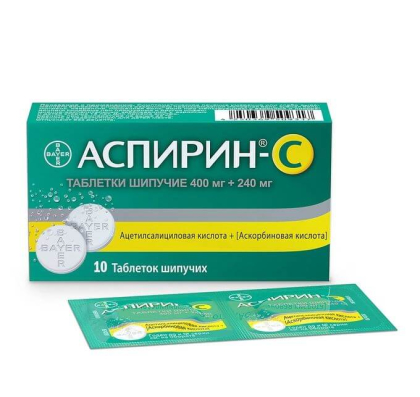Aspirin-C (ascorbic acid, acetylsalicylic acid)
Description
Instructions for Aspirin-C (ascorbic acid, acetylsalicylic acid)
Description
Round, flat, beveled to the edge of the tablet in white with an imprint in the form of a trademark ("Bayer" cross) on one side, the other side smooth.
Active substances Aspirin-C
Acetylsalicylic acid + Ascorbic acid
Release Form
Tablets
Composition Aspirin-C
1 tablet contains:
acetylsalicylic acid 400 mg,
ascorbic acid 240 mg.
Pharmacological effect Aspirin-C
Acetylsalicylic acid has regulatory properties in relation to redox processes, increases the body's resistance, has an analgesic effect, promotes a decrease in body temperature in fever conditions and has an anti-inflammatory effect. It achieves these results by suppressing COX-1 and COX-2 activity, which regulate prostaglandin synthesis, and blocking platelet binding.
Ascorbic acid also plays an important role in the body. It is involved in the regulation of redox processes, carbohydrate metabolism, blood coagulation and tissue regeneration. In addition, it helps to strengthen the body's immunity.
Pharmacokinetics Aspirin-C
After acetylsalicylic acid is taken by mouth, it is absorbed quickly and completely from the gastrointestinal tract. During absorption, it is converted into salicylic acid, which is the main active metabolite. Maximum plasma concentrations of acetylsalicylic acid are observed after 10 to 20 minutes, and of salicylate after 0.3 to 2 hours, respectively.
Acids bind completely to plasma proteins and are rapidly distributed throughout the body. Salicylic acid crosses breast milk and the placenta.
Salicylic acid metabolism occurs mainly in the liver. Its metabolites are salicyluric acid, salicylphenol glucuronide, salicylacyl glucuronide, gentisic acid, and gentysinic uric acid.
Excretion of salicylic acid from the body depends on the dosage and the body because metabolism is limited by liver enzymes. The elimination half-life ranges from two to three hours with low doses to 15 hours with high doses. Urine is the removal of salicylic acid and its metabolites.
Oral ascorbic acid is absorbed in the proximal bowel by an active sodium-ion-dependent transport system. However, absorption is not proportional to dosage: as the daily dose of ascorbic acid increases, the concentration in plasma and body fluids does not rise proportionately, but tends to reach the limit.
Ascorbic acid is filtered through the glomeruli and reabsorbed by the proximal tubules by active processes dependent on sodium ions. Oxalates and diketogulonic acid are the major metabolites excreted by the urinary system.
Testimony Aspirin-C
Drugs based on acetylsalicylic acid and ascorbic acid are used for symptomatic treatment of various pain syndromes: headaches, toothaches, migraines, neuralgias, muscle aches and pains during menstruation. They are also used to relieve fevers due to colds and other infectious-inflammatory diseases.
Method of application and dose Aspirin-C
Dissolve the effervescent tablet in a glass of water and drink.
For mild-to-moderate pain syndrome and fever, a single dose is one to two effervescent tablets, a maximum single dose is two effervescent tablets, and a maximum daily dose should not exceed six tablets. Intervals between drug doses should be at least four hours.
The duration of treatment (without consultation with a doctor) should not exceed seven days when prescribed as an anesthetic and more than three days as an antipyretic.
Features
- Expiration Date Always fresh
- Pharmacological group NSAID
- Active substance ascorbic acid, acetylsalicylic acid
- Weight 80 g
Categories: Non-steroidal anti-inflammatory Cold and Flu
Aspirin-C (ascorbic acid, acetylsalicylic acid) reviews (0)
Write a reviewBe the first to write a review of this product!
